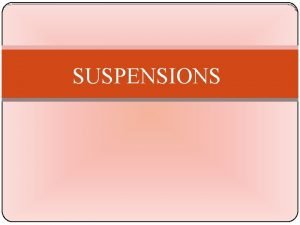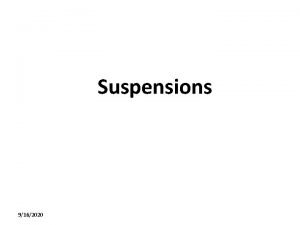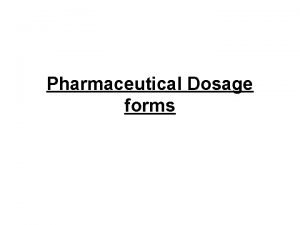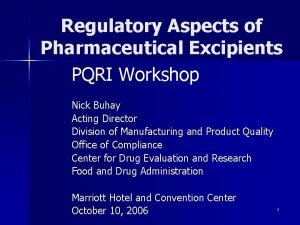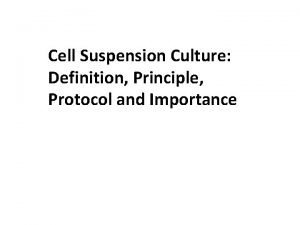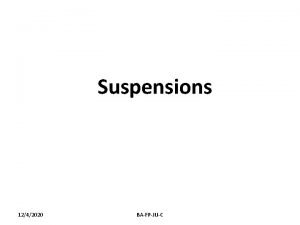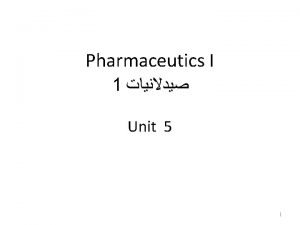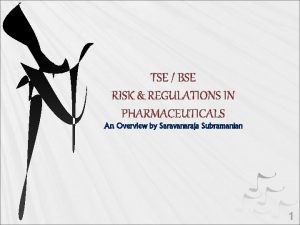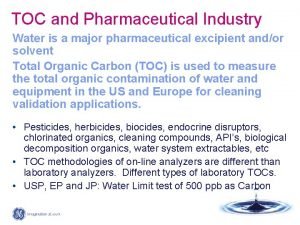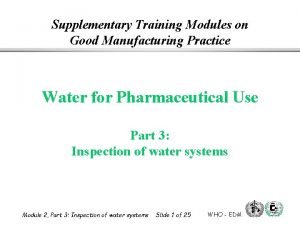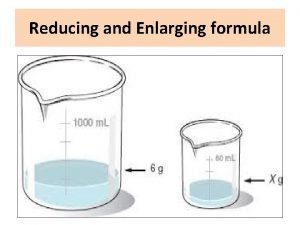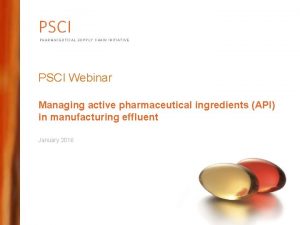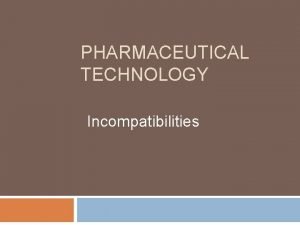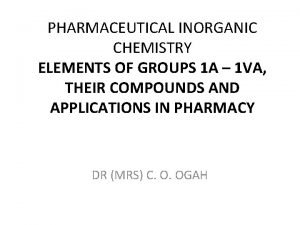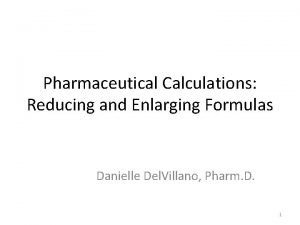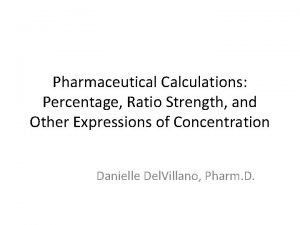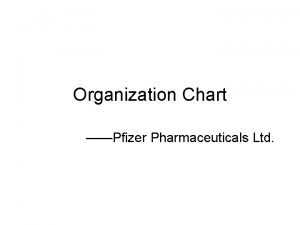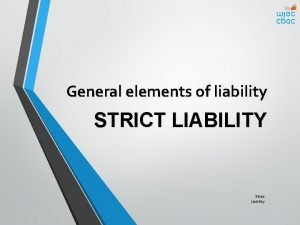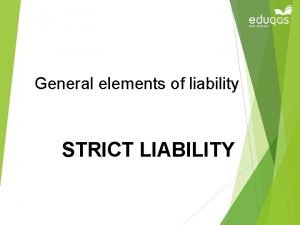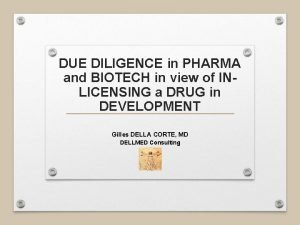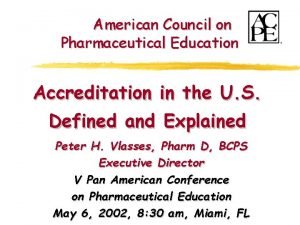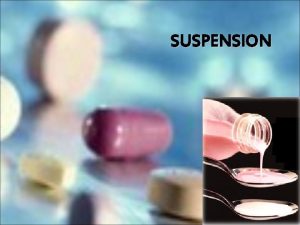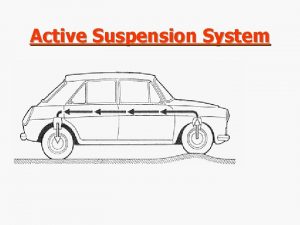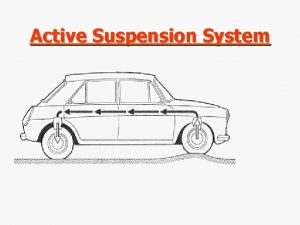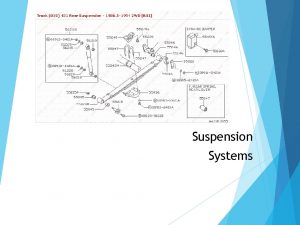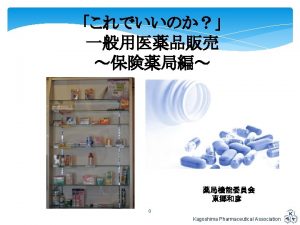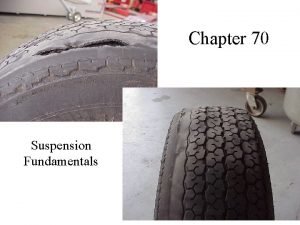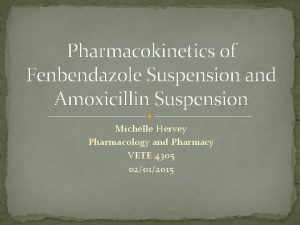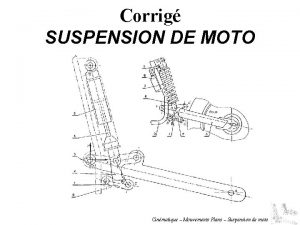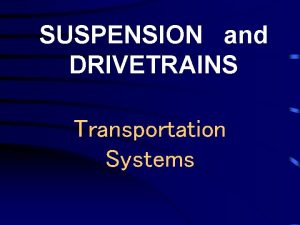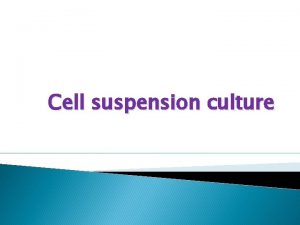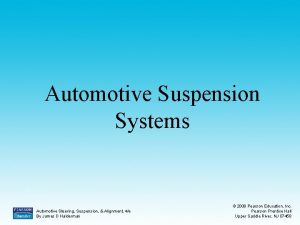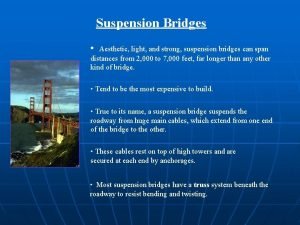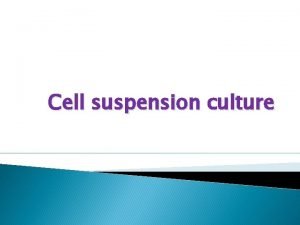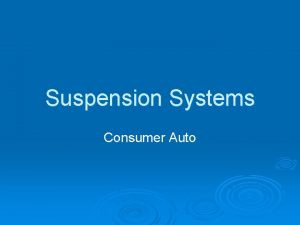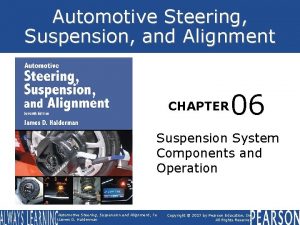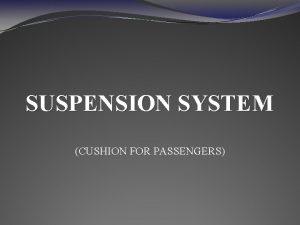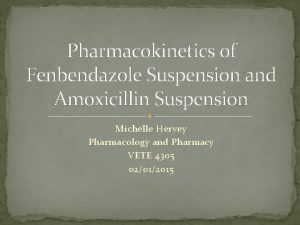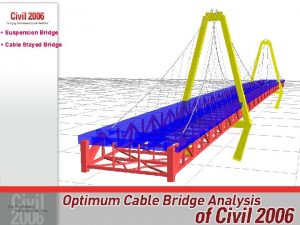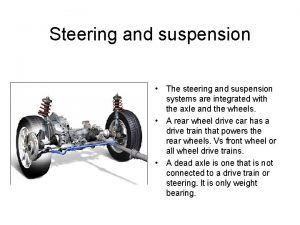Pharmaceutical suspension Definition of Suspension A Pharmaceutical suspension



































- Slides: 35

Pharmaceutical suspension

Definition of Suspension A Pharmaceutical suspension is a coarse dispersion in which internal phase is dispersed uniformly throughout the external phase. The internal phase consisting of insoluble solid particles having a specific range of size which is maintained uniformly throughout the suspending vehicle with aid of single or combination of suspending agent. The external phase (suspending medium) is generally aqueous in some instance, may be an organic or oily liquid for non oral use. Features Desired In Pharmaceutical Suspensions • The suspended particles should not settle rapidly and sediment produced, must be easily re-suspended by the use of moderate amount of shaking. • It should be easy to pour yet not watery and no grittiness. • It should have pleasing odour, colour and palatability. • Good syringeability. • It should be physically, chemically and microbiologically stable. • Parenteral/ophthalmic suspension should be sterilizable.

Classification • Based on General Classes Oral suspension Externally applied suspension Parenteral suspension • Based on Proportion of Solid Particles Dilute suspension (2 to 10%w/v solid) Concentrated suspension (50%w/v solid) • Based on Electrokinetic Nature of Solid Particles Flocculated suspension Deflocculated suspension • Based on Size of Solid Particles Colloidal suspension (< 1 micron) Coarse suspension (>1 micron) Nano suspension (10 ng)

Advantages • Suspension can improve E. g. Procaine penicillin G chemical stability of certain drug. • Drug in suspension exhibits higher rate of bioavailability than other dosage forms. bioavailability is in following order, Solution > Suspension > Capsule > Compressed Tablet > Coated tablet • Duration and onset of action can be controlled. E. g. Protamine Zinc-Insulin suspension • Suspension can mask the unpleasant/ E. g. Chloramphenicol palmitate bitter taste of drug. Disadvantages • • Physical stability, sedimentation and compaction causes problems. It is bulky sufficient care must be taken during handling and transport. It is difficult to formulate Uniform and accurate dose can not be achieved unless suspension are packed in unit dosage form

Applications • Suspension is usually applicable for drug which is insoluble or poorly soluble. E. g. Prednisolone • Suspension to prevent degradation of drug or to improve stability of drug. E. g. Oxytetracycline suspension • To mask the taste of bitter of unpleasant drug. E. g. Chloramphenicol palmitate suspension • Suspension of drug can be formulated for topical application e. g. Calamine lotion. • Suspension can be formulated for parentral application in order to control rate of drug absorption, E. g. penicillin procaine • Vaccines as a immunizing agent are often formulated as suspension. E. g. Cholera vaccine • X-ray contrast agent are also formulated as suspension. E. g. Barium sulphate for examination of alimentary tract

Theory of Suspensions • Sedimentation Behaviour: Sedimentation means settling of particle or floccules occur under gravitational force in liquid dosage form. • Theory of Sedimentation • Velocity of sedimentation expressed by Stoke’s equation 2 r 2 (ρ s- ρ o ) g V = d 2 (ρ s- ρ o ) g OR 9 V = 18 Where, v = sedimentation velocity in cm / sec d = Diameterof particle r = radius of particle ρ s= density of disperse phase ρ o = density of disperse media g = acceleration due to gravity η = viscosity of disperse medium in poise

Factors Affecting Sedimentation Particle size diameter (d) Vαd 2 • Sedimentation velocity (v) is directly proportional to the square of diameter of particle. Density difference between dispersed phase and dispersion media (ρ s - ρo) V α (ρ s - ρo) • Generally, particle density is greater than dispersion medium but, in certain cases particle density is less than dispersed phase, so suspended particle floats & is difficult to distribute uniformly in the vehicle. • If density of the dispersed phase and dispersion medium are equal, the rate of settling becomes zero.

Viscosity of dispersion medium (η ) V α 1/ ηo • Sedimentation velocity is inversely proportional to viscosity of dispersion medium. • So increase in viscosity of medium, decreases settling, so the particles achieve good dispersion system but greater increase in viscosity gives rise to problems like pouring, syringibility and redispersibility of suspensoin. Interfacial Phenomena flocculation or caking • determined by forces of attraction (van der Waals) versus forces of repulsion (electrostatic) deflocculated • repulsion> attraction • affected by [electrolytes] flocculated • attraction > repulsion

Electrical Properties particles may become charged by • adsorption of ionic species present in sol’n or preferential adsorption of OH • ionization of -COOH or -NH 2 group + + + - hydroxyl ion + solid Nernst potential § potential difference between the actual solid surface and the electroneutral bulk Zeta potential § potential difference between the tightly bound layer and the bulk § governs electrostatic force of repulsion between solid particles

Electrokinetic Phenomenon • Electrophoresis - Movement of particle in a stationary • fluid by an applied electric field. • Electro-osmosis - Movement of liquid past a surface by • an applied electric field • Streaming Potential - Creation of an electric field as a • • • liquid moves past a stationary charged surface Sedimentation Potential - Creation of an electric field when a charged particle moves relative to stationary fluid 312 PHT 10

Zeta Potential • The liquid layer surrounding the particle exists as two parts; an inner region (Stern layer) where the ions are strongly bound an outer (diffuse) region where they are less firmly associated. Within the diffuse layer there is a notional boundary inside which the ions and particles form a stable entity. When a particle moves (e. g. due to gravity), ions within the boundary move it. Those ions beyond the boundary stay with the bulk dispersant. The potential at this boundary (surface of hydrodynamic shear) is the zeta potential. 312 PHT 11

• The magnitude of the zeta potential gives an indication of the potential stability of the colloidal system. If all the particles in suspension have a large negative or positive zeta potential then they will tend to repel each other and there will be no tendency for the particles to come together. However, if the particles have low zeta potential values then there will be no force to prevent the particles coming together and flocculating. 312 PHT 12

Factors Affecting Zeta Potential (1) p. H • In aqueous media, the p. H of the sample is one of the most important factors that affects its zeta potential. A zeta potential value on its own without defining the solution conditions is a virtually meaningless number. Imagine a particle in suspension with a negative zeta potential. If more alkali is added to this suspension the particles tend to acquire more negative charge. If acid is added to this suspension then a point will be reached where the charge will be neutraliased. 312 PHT 13

Further addition of acid will cause a build up of positive charge. Therefore a zeta potential versus p. H curve will be positive at low p. H and lower or negative at high p. H. There may be a point where the plot passes through zero zeta potential. This point is called the isoelectric point and is very important from a practical consideration. It is normally the point where the colloidal system is least stable. 312 PHT 14

. 2 Conductivity • The thickness of the double layer (κ-1) depends upon the concentration of ions in solution and can be calculated from the ionic strength of the medium. The higher the ionic strength, the more compressed the double layer becomes. The valency of the ions will also influence double layer thickness. A trivalent ion such as Al 3+ will compress the double layer to a greater extent in comparison with a monovalent ion such as Na. + 312 PHT 15

. 3 Concentration of a formulation component • The effect of the concentration of a formulation component on the zeta potential can give information to assist in formulating a product to give maximum stability. The influence of known contaminants on the zeta potential of a sample can be a powerful tool in formulating the product to resist flocculation for example. 312 PHT 16

Electric Double Layer tightly bound + + + - diffuse - + + + - + gegenion zeta potential Nernst potential - + + + electroneutral bulk

Deflocculated Condition • • • repulsion energy is high particles settle slowly particles in sediment compressed over time to form a cake (aggregation) difficult to re-suspend caked sediment by agitation forms a turbid supernatant Flocculated Condition • • • weakly bonded to form fluffy conglomerates 3 -D structure (gel-like) settle rapidly but will not form a cake - resist close-packing easily re-suspended forms a clear supernatant

Advantages and Disadvantages due to viscosity of medium Advantages • High viscosity inhibits the crystal growth. • High viscosity prevents the transformation of metastable crystal to stable crystal. • High viscosity enhances the physical stability. Disadvantages • High viscosity hinders the re-dispersibility of the sediments • High viscosity retards the absorption of the drug. • High viscosity creates problems in handling of the material during manufacturing. 312 PHT 19

Sedimentation Parameters Two important parameters are considered: Sedimentation volume (F) or height (H) for flocculated suspensions Where, F = V u / VO ------- (A) • Vu = final or ultimate volume of sediment • VO = original volume of suspension before settling. • Sedimentation volume is a ratio of the final or ultimate volume of sediment (Vu) to the original volume of sediment (VO) before settling. Sedimentation volume can have values ranging from less than 1 to greater than 1; F is normally less than 1. F=1, such product is said to be in flocculation equilibrium, and show no clear supernatant on standing

Suspensions quantified by sedimentation volume (f)

The Sedimentation Behavior of Flocculated and Deflocculated Suspensions Flocculated Suspensions • In flocculated suspension, formed flocks (loose aggregates) will cause increase in sedimentation rate due to increase in size of sedimenting particles. Hence, flocculated suspensions sediment more rapidly. • Here, the sedimentation depends not only on the size of the flocs but also on the porosity of flocks. In flocculated suspension the loose structure of the rapidly sedimenting flocs tends to preserve in the sediment, which contains an appreciable amount of entrapped liquid. The volume of final sediment is thus relatively large and is easily redispersed by agitation.

The Sedimentation Behavior of Deflocculated Suspensions • In deflocculated suspension, individual particles are settling, so rate of sedimentation is slow which prevents entrapping of liquid medium which makes it difficult to re-disperse by agitation. • This phenomenon also called ‘cracking’ or ‘claying’. In deflocculated suspension larger particles settle fast and smaller remain in supernatant liquid so supernatant appears cloudy whereby in flocculated suspension, even the smallest particles are involved in flocs, so the supernatant does not appear cloudy.

Fig 2: Sedimentation behaviour of flocculated and deflocculated suspensions

Flocculating Agents Flocculating agents decreases zeta potential of the suspended charged particle and thus cause aggregation (flock formation) of the particles. Examples of flocculating agents are: • • Neutral electrolytes such as KCl, Na. Cl. Surfactants Polymeric flocculating agents Sulfate, citrates, phosphates salts • Neutral electrolytes e. g. Na. Cl, KCl besides acting as flocculating agents, also decreases interfacial tension of the surfactant solution. If the particles are having less surface charge then monovalent ions are sufficient to cause flocculation e. g. steroidal drugs. • For highly charged particles e. g. insoluble polymers and poly-electrolytes species, di or trivalent flocculating agents are used.

Method of Floccules Formation The different methods used to form floccules are mentioned below: 1. Electrolytes: Electrolytes decrease electrical barrier between the particles and bring them together to form floccules. They reduce zeta potential near to zero value that results in formation of bridge between adjacent particles, which lines them together in a loosely arranged structure. 2. Surfactants: Both ionic and non-ionic surfactants can be used to bring about flocculation of suspended particles. Optimum concentration is necessary because these compounds also act as wetting agents to achieve dispersion. Optimum concentrations of surfactants bring down the surface free energy by reducing the surface tension between liquid medium and solid particles. This tends to form closely packed agglomerates. The particles possessing less surface free energy are attracted towards to each other by van der-waals forces and forms loose agglomerates.

3. Polymers: Polymers possess long chain in their structures. Example- Starch, alginates, cellulose derivatives, carbomers, tragacanth The part of the long chain is adsorbed on the surface of the particles and remaining part projecting out into the dispersed medium. Bridging between these later portions, also leads to the formation of flocs. Viscosity of Suspensions: Viscosity of suspensions is of great importance for stability and pourability of suspensions. As we know suspensions have least physical stability amongst all dosage forms due to sedimentation and cake formation. So as the viscosity of the dispersion medium increases, the terminal settling velocity decreases thus the dispersed phase settle at a slower rate and they remain dispersed for longer time yielding higher stability to the suspension. On the other hand as the viscosity of the suspension increases, it’s pourability decreases and inconvenience to the patients for dosing increases. Thus, the viscosity of suspension should be maintained within optimum range to yield stable and easily pourable suspensions.

Different Approaches to Increase the Viscosity of Suspensions Various approaches have been suggested to enhance the viscosity of suspensions. Few of them are as follows: 1. Viscosity Enhancers: Some natural gums (acacia, tragacanth), cellulose derivatives (sodium CMC, methyl cellulose), clays(bentonite, veegum), carbomers, colloidal silicon dioxide (Aerosil), and sugars (glucose, fructose) are used to enhance the viscosity of the dispersion medium. They are known as suspending agents. List of Suspending Agents Alginates Acacia, Tragacanth, Xanthan gum Methylcellulose Bentonite Hydroxyethylcellulose Carbomer Carboxymethylcellulose Sodium Carboxymethylcellulose Microcrystalline cellulose Powdered cellulose Gelatin

2. Co-solvents: Some solvents which themselves have high viscosity are used as co-solvents to enhance the viscosity of dispersion medium. Example- Glycerol, propylene glycol, sorbitol. • Most suspending agents perform two functions i. e. besides acting as a suspending agent they also imparts viscosity to the solution. Suspending agents form film around particle and decrease interparticle attraction. • A good suspension should have well developed thixotropy. • At rest the solution is sufficient viscous to prevent sedimentation and thus aggregation or caking of the particles. When agitation is applied the viscosity is reduced and provide good flow characteristic from the mouth of bottle. Thixotropy: Thixotropy is defined as the isothermal slow reversible conversion of gel to sol. Thixotropic substances on applying shear stress convert to sol(fluid) and on standing they slowly turn to gel (semisolid).

3. Wetting Agents: Hydrophilic materials are easily wetted by water while hydrophobic materials are not. However hydrophobic materials are easily wetted by non-polar liquids. The extent of wetting by water is dependent on the hydrophillicity of the materials. If the material is more hydrophilic it finds less difficulty in wetting by water. Inability of wetting reflects the higher interfacial tension between material and liquid. The interfacial tension must be reduced so that air is displaced from the solid surface by liquid. • Non-ionic surfactants are most commonly used as wetting agents in pharmaceutical suspension. Non-ionic surfactants having HLB value between 7 -10 are best as wetting agents. High HLB surfactants act as foaming agents. The concentration used is less than 0. 5 %. A high amount of surfactant causes solubilization of drug particles and causes stability problem. • Ionic surfactants are not generally used because they are not compatible with many adjuvant and causes change in p. H.

4. Surfactants: Surfactants decrease the interfacial tension between drug particles and liquid and thus liquid is penetrated in the pores of drug particle displacing air from them and thus ensures wetting. • Surfactants in optimum concentration facilitate dispersion of particles. Generally we use non-ionic surfactants but ionic surfactants can also be used depending upon certain conditions. • Disadvantages of surfactants are that they have foaming tendencies. • Further they are bitter in taste. Some surfactants such as polysorbate 80 interact with preservatives such as methyl paraben and reduce antimicrobial activity. • All surfactants are bitter except Pluronics and Poloxamers. • Polysorbate 80 is most widely used surfactant both for parenteral and oral suspension formulation. • Polysorbate 80 is also adsorbed on drug particle and decreases its zeta potential. This effect of polysorbate 80 stabilizes the suspension. • Polysorbate 80 stabilized suspensions through steric mechanism. At low concentration of polysorbate 80, only partial stabilization of suspension was observed.

• In absence of polysorbate 80, difficulty was observed in re-dispersion of sedimented particles. • Polysorbate 80 is most widely used due to its following advantages • It is non-ionic so no change in p. H of medium • No toxicity. • Safe for internal use. • Less foaming tendencies however it should be used at concentration less than 0. 5%. • Compatible with most of the adjuvant. Hydrophilic Colloids • Hydrophilic colloids coat hydrophobic drug particles in one or more than one layer. This will provide hydrophillicity to drug particles and facilitate wetting. • They cause deflocculation of suspension because force of attraction is declined. e. g. acacia, tragacanth, alginates, guar gum, pectin, gelatin, wool fat, egg yolk, bentonite, Veegum, Methylcellulose etc.

Solvents: The most commonly used solvents used are alcohol, glycerin, polyethylene glycol and polypropylene glycol. The mechanism by which they provide wetting is that they are miscible with water and reduce liquid air interfacial tension. Liquid penetrates in individual particle and facilitates wetting. Components Function API Wetting agents Active drug substances They are added to disperse solids in continuous liquid phase. Flocculating agents They are added to floc the drug particles Thickeners They are added to increase the viscosity of suspension. Buffers and p. H adjusting agents They are added to stabilize the suspension to a desired p. H range. Osmotic agents They are added to adjust osmotic pressure comparable to biological fluid. Coloring agents They are added to impart desired color to suspension and improve elegance. Preservatives They are added to prevent microbial growth. External liquid vehicle They are added to constructure of the final suspension.

Quality Control of Suspensions The following tests are carried out in the final quality control of suspension: • Appearance Color, odor and taste • Physical characteristics such as particle size determination and microscopic photography for crystal growth • Sedimentation rate and • Zeta Potential measurement • Sedimentation volume • Redispersibility and Centrifugation tests • Rheological measurement • Stress test • p. H • Freeze-Thaw temperature cycling • Compatibility with container and cap liner

Ideal Requirements of Packaging Material • It should be inert. • It should effectively preserve the product from light, air, and other contamination through shelf life. • It should be cheap. • It should effectively deliver the product without any difficulty.
 Classification of suspension
Classification of suspension List of suspending agents
List of suspending agents Axial suspension
Axial suspension Importance of inorganic chemistry in pharmacy
Importance of inorganic chemistry in pharmacy What is dosage form
What is dosage form Pharmaceutical marketing definition
Pharmaceutical marketing definition Pharmaceutical excipients definition
Pharmaceutical excipients definition Acts in pharmaceutical jurisprudence
Acts in pharmaceutical jurisprudence Market access definition pharmaceutical
Market access definition pharmaceutical Pharmaceutical biotechnology definition
Pharmaceutical biotechnology definition Culture definition
Culture definition Pediatric chalk mixture
Pediatric chalk mixture Suspension definition pharmacy
Suspension definition pharmacy Tse bse certificate in pharmaceutical
Tse bse certificate in pharmaceutical Toc in pharmaceutical industry
Toc in pharmaceutical industry Importance of quality in pharmaceutical industry
Importance of quality in pharmaceutical industry Validation of water systems for pharmaceutical use
Validation of water systems for pharmaceutical use Retention samples of finished product
Retention samples of finished product Reducing and enlarging
Reducing and enlarging Pharmaceutical supply chain initiative psci
Pharmaceutical supply chain initiative psci Pharm degree
Pharm degree What goes in black pharmaceutical waste containers
What goes in black pharmaceutical waste containers Examples of physical incompatibility
Examples of physical incompatibility Pharmaceutical compliance congress
Pharmaceutical compliance congress Nuclear charge definition
Nuclear charge definition Reducing and enlarging formulas in pharmacy
Reducing and enlarging formulas in pharmacy Pharmaceutical calculations
Pharmaceutical calculations Pfizer organizational chart 2021
Pfizer organizational chart 2021 Good manufacturing practices in pharmaceutical industry
Good manufacturing practices in pharmaceutical industry Elements of strict liability
Elements of strict liability Callow v tillstone
Callow v tillstone Clinical due diligence checklist
Clinical due diligence checklist Harrow lbc v shah
Harrow lbc v shah Rowe handbook of pharmaceutical excipients
Rowe handbook of pharmaceutical excipients American council on pharmaceutical education
American council on pharmaceutical education Active pharmaceutical ingredient sourcing
Active pharmaceutical ingredient sourcing
